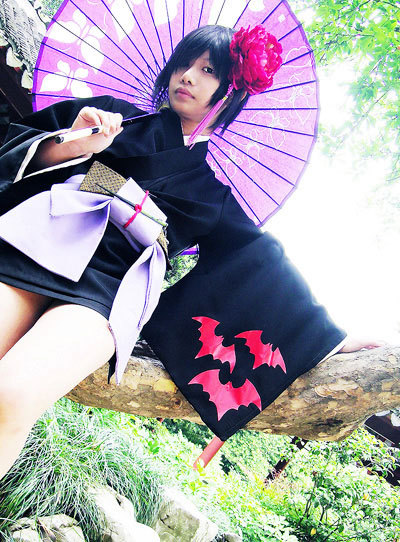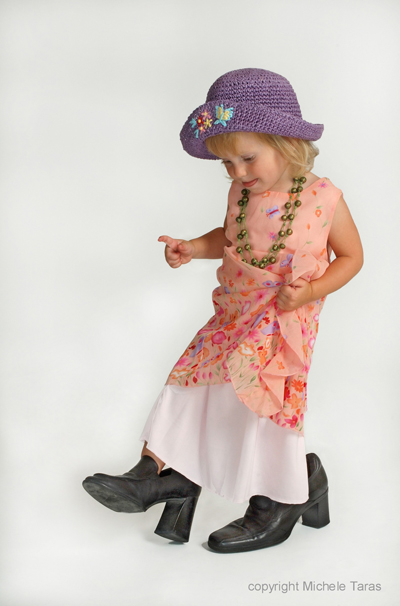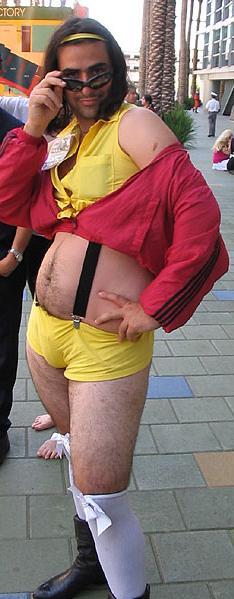“You are Now Entering a No-Passing Zone”: A History of Passing and its Contemporary Application in Cosplay
“You are Now Entering a No-Passing Zone”: A History of Passing and its Contemporary Application in Cosplay
I have been engaging in a so-called deviant act known as cosplaying for five years, but really, I feel like the trend of dressing up spans all the way back to our earliest childhood. We dressed as princesses, princes, and occasionally dragons, trying to capture that other person, that other identity that we wanted to be, even if only for an hour. Now, after a semester of a gender course, my first inclination is to jump on this action as an early act of passing. But, wanting to be a princess is not gender passing, not if you are female, and it is not racial passing because princesses do not have a set race (even Disney agrees). Perhaps class passing? Is it really as simple as that? Do we need to label such whimsy as “passing?”
A game studies writer named Callois commented that “…acts of mimicry tend to cross the border between childhood and adulthood. The pleasure lies in being or passing for another…pleasure in secrecy, make-believe, or disguise.” (‘Playing Dress Up,’ pg.3) First off, this places a certain amount of deceit into the actions of small children, and I find that disturbing. Secondly, this theory rings in much the same way that the later negative critiques of racial and sexual passing do. Is passing wrong?
Most racial theorists would say that, yes, passing involves denying an entire aspect of one’s existence, and such an action is to partially deny oneself. Why, therefore, is an act like cosplay, or dress-up, viewed less harshly? Is there such a difference between “serious business” and “play-time?”
To try and answer these questions, I am going to look at a brief history of racial and sexual passing (and perhaps allusions to class passing, as well) and then tie some of the theories on these topics into the modern phenomenon of cosplay, the so called “dress-up for adults.”
The History of Passing
(This will be a very basic explanation. For more detail, and an excellent paper, check out aaclh’s “Should One Cross the Line?“)
Racial passing is a phrase used to describe the act of a person of one ethnicity (usually a minority) choosing to identify with another ethnicity (usually white). This practice was most common in the US during the times of racial segregation, especially amongst the black community. If a person had skin light enough, or looked “white enough,” they would introduce themselves as white, and attempt to integrate with the white community. Racial passing was however firmly discouraged by slave owners, and other segregationalist whites, who believed that a black passing as white would “contaminate” the white bloodline, and would often hang multiracial people attempting to pass for white if they were caught.
Thus, racial passing was done as a method of survival, or done to “level the playing field.” More opportunities were given to whites during the 19th and early 20th centuries, so assuming the identity of a white person allowed that person to have more opportunities and potentially lead a more successful life.
However, racial passing has been negatively regarded by most, called a “deception.” While passing may have been a way for a person to “beat the system,” and “work without a colored label,” passing was also considered a deceitful act, because it involved denying a whole part of one’s heritage. Also, people who “passed for white” would sometimes abandon their family so as to further embrace their white identity.
Despite the negativity, many people who did pass, or knew people who had done so successfully, said that the choice to pass was not really a choice at all. A “biracial” psychologist named Juanita Brooks remarked, “The word ‘multiracial’ was not in our vocabulary back then. You had to choose — society made you choose. (Crary 1)” The lack of acceptance towards a “biracial or “multiracial” identity made people give up one aspect of their lives, their existence. And if you, right now, were forced to choose whether to give up your family or your only hope for a life where-in you were not looked down on or scorned, you would be hard-pressed to make a decision. That is what passing is, giving up one part of your self to embrace another.
Gender passing was first observed during wartime, when women wished to serve in their nation’s army, but were prohibited. These women, for whatever motivation, disguised themselves as men to fight, and had to live as a man, amidst large groups of men. Often, discovery was not a concern, because another body willing to fight was another soldier “for the cause.” However, a woman alone amongst some hundred soldiers could face hardships, and in this case, the disguise was for safety and survival. This type of gender passing had nothing to do with gender or sexual identity, but with necessity.
In contrast, modern gender passing is entirely about one’s identity, either sexually or otherwise. In the transgender community, there is a disagreement towards gender-passing with many transgendered people trying to be accepted as the gender that they identify most with, rather than their “natal sex.” There are either permanent or temporary methods for passing, with temporary encompassing prosthetic breasts, binding, packing, wigs, and corsets and permanent being related to surgery.
For those transgenders who are aiming for operation, there is also a difference in whether the operation has been performed, or not. A pre-operation person will tend to “pass,” as the gender they desire, because they do not currently have the body that “backs up” their ideal gender. Therefore, they are passing because they are trying to be something they are not. A post-operation person, however, will “live in stealth,” meaning that they will likely never discuss the particulars of the operation, or their natal sex.
As another contrast, there are those transgendered individuals who wish to embrace their “trans” nature, and do not attempt any form of passing. These people either allow other people to form their own opinions about their gender identity unless confronted by it, or choose to “give mixed signals.” Such mixed signals could include acting with a stereotypical male attitude one day, and the next giving off stereotypically female “vibes.” The resulting confusion can be “fun, and exhilarating,” and may also allow the person to feel more confident because it is not that they are unable to pass, it is that they choose not too.
Passing also comes into play when a person who is of a sexual identity not in the majority will attempt to accept that sexuality to fit in with the society. In general, this occurs when a homosexual individual wants to fit into a heterosexual environment, he or she will adopt the heteronormative traits of that group. The reverse may also occur, when an “unusual” sexual identity may be “popular,” and therefore peer pressure may push the individual to adopt a new sexual identity.
It should be noted that the use of the term “passing” regarding sexual orientation denotes “hiding” one’s identity, where use among gender-variant people (as noted above) signals acceptance and concordance with one’s internal sense of or desired gender identity. However, for this reason, and because transgender persons who come to live full-time in their desired gender/sex identity often recognize their previous attempts to conceal their identity and be accepted in socially-accepted and designated roles as the real artifice they constructed and protected, some have begun to instead call their previous gender-normative and concealing behaviors as “passing” (Wikipedia).
The History/Sub-culture of Cosplay
The word cosplay originated in 1984 and comes from Japanese コズプレ(kosupure), which is an abbreviation of “costume play.” Cosplay is an activity whereby a person dresses as a character from a television series, movie, anime, or video game. The costume worn can be either purchased, commissioned, or made by the wearer themselves. Contrary to expectation, the origin of cosplay itself is not a Japan, but rather the United States.
A science fiction convention called the First World Science Fiction Convention held in New York in 1939 is cited as the earliest instance of masquerade, or cosplay. Two attendees dressed in home-made costumes as characters from a popular 1933 movie, and thus brought masquerade to the U.S. From then on, most conventions, Renaissance fairs, and the like involved people dressing as familiar fictional characters, and it was not until 1984 that cosplay reached Japan.
A Japanese magazine reporter was impressed with the craftsmanship and creativity in the costumes at a science fiction con, and reported his enthusiasm in Japanese magazines. From there, the cosplay trend in Japan caught on, and now cosplayers can be found most days of the year in areas like Akihabara (the electric city) and Harajuku(famous for its own, interesting, fashion style). There are also locations called maid cafes, where-in customers can be served by young women dressed in maid outfits, or cosplay cafes where the waitresses are in full cosplay.
 In “geek areas” like Akihabara or Harajuku, cosplayers parade about in their costumes having pictures taken of them by cameko (a shortening of kamera-kozo meaning camera-boys). These cameko then offer the pictures back to the cosplayers as a gift for a well done cosplay. A stalker-like culture has also developed amidst the cameko, with some having an obsessive dedication to their favored cosplayer. The sexualization of cosplay, visible through provocative and bordering on soft-core porn websites, is not to be confused with the Japanese “practice” of cosplay in sex. While some love hotels may rent out costumes, that is not the type of cosplay I am discussing.
In “geek areas” like Akihabara or Harajuku, cosplayers parade about in their costumes having pictures taken of them by cameko (a shortening of kamera-kozo meaning camera-boys). These cameko then offer the pictures back to the cosplayers as a gift for a well done cosplay. A stalker-like culture has also developed amidst the cameko, with some having an obsessive dedication to their favored cosplayer. The sexualization of cosplay, visible through provocative and bordering on soft-core porn websites, is not to be confused with the Japanese “practice” of cosplay in sex. While some love hotels may rent out costumes, that is not the type of cosplay I am discussing.
The reason I hesitate to use the term “cosplay” in regards to the 1939 convention touches on the key differences between Japanese cosplay and its Western cousin. Because the US had masquerade, where-in people dressed exclusively as characters from science fiction and fantasy, the term cosplay has taken on the meaning of a masquerade with characters from anime or manga (or other Japanese media) only. Whereas, in Japan, which had no such masquerade, the word cosplay applies to all genres (or obsessive fandoms), including fantasy and science fiction.
 Another difference is that while Japanese cosplay is entirely about “living” the character (i.e. thinking, walking, and acting like the character), Western cosplay is concerned only with the costume. A cosplayer can choose to act the part of the character or not, and receive no criticism for his or her choice. However, in Japan, being caught out of character is tantamount to being caught naked in the streets.
Another difference is that while Japanese cosplay is entirely about “living” the character (i.e. thinking, walking, and acting like the character), Western cosplay is concerned only with the costume. A cosplayer can choose to act the part of the character or not, and receive no criticism for his or her choice. However, in Japan, being caught out of character is tantamount to being caught naked in the streets.
Another interesting thing to note about Japanese cosplay is that, unlike the US, the Japanese culture does not encourage individuality because it is a conformist society. Unlike the US where nonconformity is greeted with acceptance, even if that acceptance is tempered with exasperation, Japan has the saying “the nail that sticks out gets hammered back in.” Therefore, the youth movements currently ongoing in Japan have a much more serious edge than those in the US, because the person “rebelling” risks being figuratively exiled from the culture.
One should not be confused with the idea that Cosplay is considered typical behavior in Japan. While some do attend Cosplay functions that are held in districts such as Akihabara, most Japanese people find Cosplay to be rather silly. In addition, because Cosplay in Japan has adapted such a negative sexual connotation, many Japanese have come to feel that Cosplay is reprehensible. In addition, North Americans who Cosplay typically refer to themselves as “otaku”, which is essentially the Japanese word for “geek”, but wrongfully use this word in an attempt to embody themselves in a sociological group that they can be proud of. To contrast, in Japan actual otaku refuse to admit that they are otaku because the idea of otaku it is not looked at as a group of people who are engaging in activity that may seem “just a little different”. In fact, being an otaku in Japan entails standing on one of the bottom rungs of the Japanese social ladder. (Harajuku blogspot)
Sexuality and Gender Identity in Cosplay
As I mentioned, Japanese cosplay is dominated by young women, mostly because the anime industry is full of women and androgynous young men, which are roles young women can “pull off” better. Western cosplay, in contrast, has many more males involved in cosplay, which leads us to the discussion of “cross-play.” Cross-play refers to a cosplayer who is wearing a costume of a character of the opposite sex. This is not to be confused with cross-dressing, where-in a person dresses in the clothes of the other sex, but is not assuming another gender.
Cross-play happens most frequently with females dressing as male characters because of the aforementioned androgyny of most male characters in anime. The other reason more women cross-play is because society finds “FtM” crossplayers much more “acceptable” than “MtF” crossplayers. In some countries, though, “FtM” crossplayers have a stigma with those outside the cosplay community of being lesbians, transgender, or having penis-envy. However, for those within the cosplay community, this crossplay is a case of wanting to portray a favorite character, regardless of gender.
 “MtF” crossplayers are far more common outside of Japan, and also face a great deal of criticism and stigmas. This group of crossplayers is divided into two groups: those attempting to pass as women, and those treating the cosplay as a parody. For the first group, a great deal of effort is put into creating a female persona, with special attention placed on trying to “fool” the general populous. The term “trap,” has been negatively applied to these crossplayers, because on first impression they appear female, but on closer inspection are male. Online forums or even conventions are full of people accusing cosplayers of being “traps!” as a sort-of warning; these individuals are usually criticized as being homosexual. However, as Karisu-sama, the self-proclaimed “cosplay mom” points out:
“MtF” crossplayers are far more common outside of Japan, and also face a great deal of criticism and stigmas. This group of crossplayers is divided into two groups: those attempting to pass as women, and those treating the cosplay as a parody. For the first group, a great deal of effort is put into creating a female persona, with special attention placed on trying to “fool” the general populous. The term “trap,” has been negatively applied to these crossplayers, because on first impression they appear female, but on closer inspection are male. Online forums or even conventions are full of people accusing cosplayers of being “traps!” as a sort-of warning; these individuals are usually criticized as being homosexual. However, as Karisu-sama, the self-proclaimed “cosplay mom” points out:
Neither crossplaying nor crossdressing actually indicate anything about a person’s sexual orientation. You CANNOT tell if a crossplayer is Gay, Het or Bi just by the fact that they crossplay. As for crossdressing, whether in cosplay or even in mundane life, it may or may not indicate something about a person’s gender identity, so NEVER ASSUME, because you could indeed be wrong. (Cosplaylab.com forums)
The second category of “MtF” crossplayers play up the ironic humor of crossplaying, and avoid passing entirely because ” for most males, dressing in women’s clothing is not something to be taken lightly (Crossplay 3).” The main negative stereotype of male to female crossplayers is that many anime females in series like Sailor Moon involve impossibly short skirts, male cosplayers are all hairy and overweight. This stereotype has in term given rise to cosplayers like Sailor Bubba and Man-Faye, both of whom attempt to make light of the fact that they are clearly men wearing women’s clothing.
Passing in cosplay is a matter of choice. Personal preferences towards a character will make way for dressing and acting as another gender, or as another person entirely. However, Western cosplay has much less in common with passing because it does not have the extreme focus on playing the character, or on portraying the role convincingly. Japanese cosplayers may be said to be passing by those outside of the cosplay community, but within the cosplay “bubble,” passing is played off as an expression of one’s interests. So, even though a “MtF” crossplayer may be called a “trap,” the teasing is honestly good-natured, and generally is considered a compliment for a costume well done.
The cosplay situation in Japan is a unique one, because in a way, the cosplayers are taking on a different persona to reach individuality, which seems unusual for people from a culture where we prize individuality. The nature of passing in Japan is complicated because daily, people are passing to try and fit the cultural and societal norms of their country. So, when a young woman becomes a male, in persona and dress at least, for a day, is she passing as well? Or is she breaking out of the cycle of passing that so many Japanese are a part of?
Different cosplayers have different views, of course, and it all depends how far a person wants to take the masquerade. An example from the Cosplaylab.com forums:
Rosie: I have to say, I’m frankly bothered by the notion that I’ve gotten from quite a few cosplayers that you can only truly be yourself when you’re in costume. I’m more than capable of expressing myself out of costume, and I think it says more about the people who wear theirs all the time than it does about those of us who don’t. Cosplayers aren’t an oppressed minority, we’re a bunch of nerds who like to play dress-up. It’s really as simple as that.
Miyabi: So by dressing as someone else you’re being yourself? I…don’t get it.
As a conclusion, while cosplay may be considered “play” by some, others take it farther and devote their lives to becoming another person. Passing may be the word used by some psychologists on the outside looking in, but for those involved, passing is never a part of cosplay. We are expressing out affections for a character, or an anime, not trying to engage in any deviant behavior. The phrase “dress-up for grown-ups” definitely applies, because just like the children playing dress-up in their basement for fun, we do not try and psychoanalyze our own actions. Cosplay represents a unique opportunity in that it allows people to experiment with gender and sexual identity in a safe environment, namely that of a community of “players.”
My feelings towards passing is that ideally, someday there should be no need for “serious” passing like racial and gender passing. But, I understand that as long as there is an “ideal” image of people, there will be passing to try and fit into that ideal. As Kroeger remarks “If revealed, an act of passing can force those in the passer’s wake to rethink what made the passing necessary in the first place. It’s not too much of a stretch to see passing as an instrument of social change (Crary 2).” So, we should move towards a day where we no longer have to pass, and all people can express every part of themselves in the open. Until that day, I will keep cosplaying, and expressing aspects of my self, one persona at a time.
EDIT: Here’s the short movie I made to go with the paper. You should check it out!
Works Cited:
-Brightman, James. “Asian Cultural Brief: Japan.” http://www.ntac.hawaii.edu/downloads/products/briefs/culture/pdf/ACB-Vol2-Iss6-Japan.pdf 2005.
-“Playing Dress Up.” <http://www.ludica.org.uk/LudicaDress-Up.pdf>
-“Cosplay.” Wikipedia. <http://en.wikipedia.org/wiki/Cosplay>
-“Crossplay.” Wikipedia. <http://en.wikipedia.org/wiki/Crossplay>
-“Passing (gender).” Wikipedia. <http://en.wikipedia.org/wiki/Passing_(gender)>
-“Passing (racial).” Wikipedia. <http://en.wikipedia.org/wiki/Passing_(racial_identity)>
-Crary, David. “Race Matters – Passing for White.” <http://www.racematters.org/passingforwhite.htm> November 1, 2003
-Harajuku Blog Spot. <http://harajukus.blogspot.com/>
-Flynn, John. “Costuming History.” <http://www.costuming.org/history.html>
-Ginsense. “History of Cosplay: Yahoo, answers.” <http://answers.yahoo.com/question/index?qid=20080921071918AA11xes>
-Karisu-sama. “FAQ: What is crossplay?” <http://www.cosplay.com/showthread.php?t=18966> 2003.
Images from:
Google Image Search
Cosplaylab.com
“Nanao’s Cosplay Research.” <http://blog.sanriotown.com/nanao_chan:kuririnmail.com/>
4-chan’s /cgl board <http://zip.4chan.org/cgl/imgboard.html>
“Femulate: the weblog of a male who emulates a female.” <http://femulate.blogspot.com/2007_06_01_archive.html>




